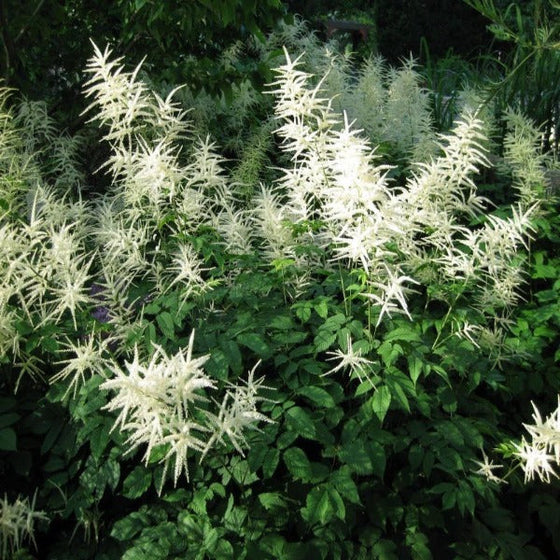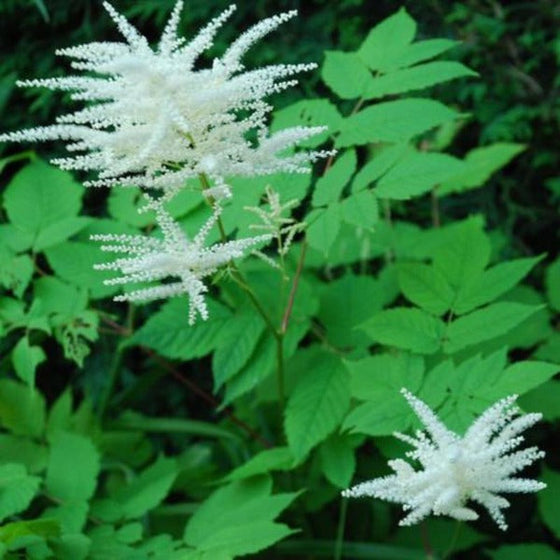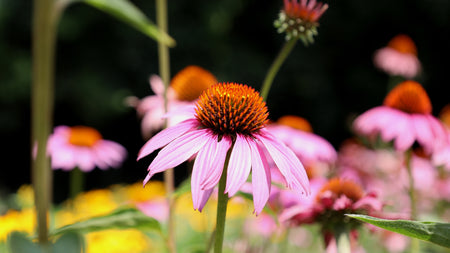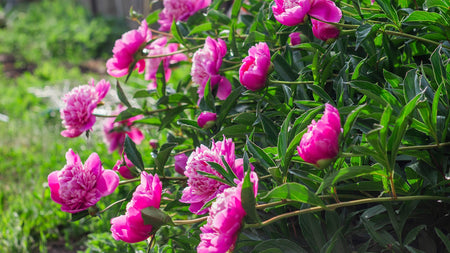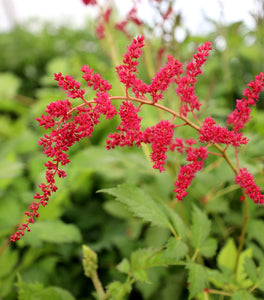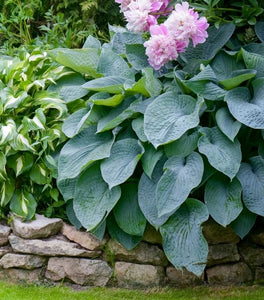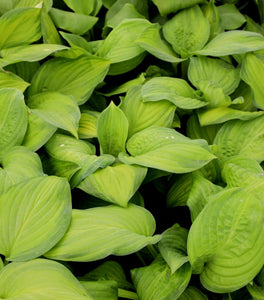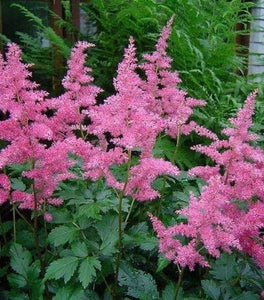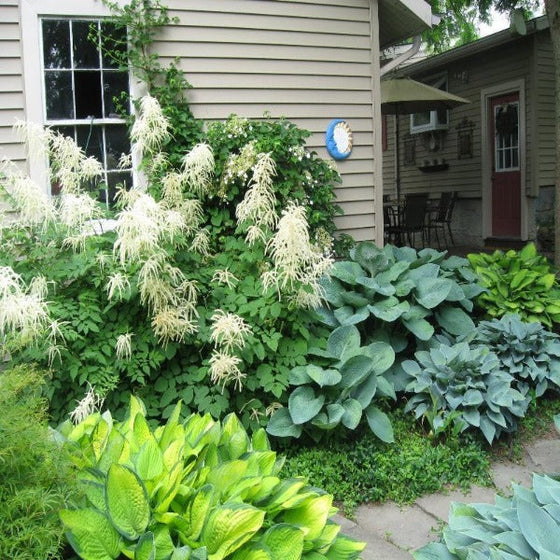
Images Depict Mature Plants
Aruncus Dioicus Plants
Aruncus dioicus, commonly known as Goat’s Beard, is a bold, native perennial prized for its dramatic, feathery white plumes and elegant, fern-like foliage. Blooming in early to mid-summer, this shade-loving plant creates a striking presence in woodland gardens, shady borders, and moist meadows. The tall, creamy-white flower spikes can reach up to 4 to 6 feet in height, creating a showy display that resembles a giant astilbe. Its lush texture and vertical interest make it a standout focal point in the landscape, while also serving as a backdrop for smaller shade perennials.
This hardy perennial thrives in part shade to full shade and prefers moist, rich, well-drained soil, making it ideal for areas with dappled light and consistent moisture. It performs well in rain gardens, naturalized settings, and along streambanks, where it helps control erosion and supports biodiversity. Aruncus dioicus is native to North America and well-suited to USDA Zones 3–7, making it a resilient, long-lived choice for gardeners seeking both beauty and ecological function. It’s also deer-resistant and pollinator-friendly, attracting beneficial insects such as bees during its bloom period.
With its majestic form, native origins, and adaptability, Goat’s Beard (Aruncus dioicus) adds texture, movement, and seasonal interest to shaded landscapes. Perfect for mass plantings, specimen use, or as a companion to hostas, ferns, and astilbes, this perennial brings structure and elegance to garden designs. Whether you’re enhancing a woodland edge or designing a pollinator haven, Aruncus dioicus is a reliable, low-maintenance option that delivers both aesthetic and environmental value year after year.
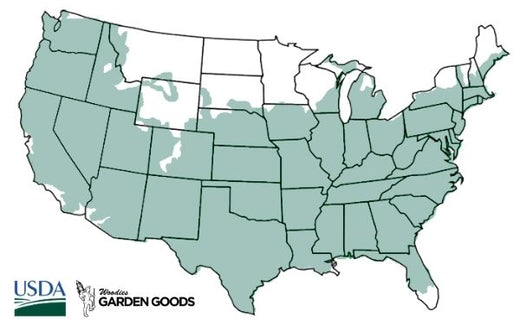
| Hardiness Zone: | 3-9 |
|---|---|
| Mature Height: | 4 to 6 Feet |
| Mature Width: | 4 to 6 Feet |
| Classification: | Perennial |
| Sunlight: | Full Shade to Part Sun |
| Habit: | Upright, spreading |
| Flower Color: | Pure white flowers |
| Flowering Season: | Late Spring through Early Summer |
| Foliage: | Green |
| Soil Condition: | Prefers average to moist soil |
| Water Requirements: | Water well until established |
| Uses: | Extremely attractive when used as a focal point in the mixed border, mass planting. Attracts pollinators |
How to Care for Aruncus Dioicus
Be sure to read our planting instructions to ensure a healthy and happy Aruncus dioicus Plants for years to come!
How Do I Plant My Aruncus Dioicus Plants?
To plant your Aruncus dioicus (Goat’s Beard) successfully, choose a location with part shade to full shade and consistently moist, well-drained soil. This native perennial thrives in woodland settings, rain gardens, and along streambanks where soil remains cool and moist throughout the growing season. Begin by loosening the soil and incorporating compost or organic matter to enhance drainage and nutrient content. Dig a hole twice as wide and as deep as the root ball, place the plant so the crown is level with the soil surface, and backfill with enriched soil. Water deeply after planting to help settle the soil and remove any air pockets. Space Aruncus dioicus plants approximately 2 to 3 feet apart to accommodate their mature size and allow for good air circulation. Mulch around the base with 2–3 inches of organic mulch to conserve soil moisture, suppress weeds, and regulate soil temperature, especially during hot summer months. Avoid planting in dry or sandy soils, as this moisture-loving plant may struggle without consistent hydration. When planted in the right conditions, Goat’s Beard becomes a long-lived, low-maintenance perennial that delivers bold texture and elegant white plumes year after year in shaded, naturalistic landscapes.
How Do I water My Aruncus Dioicus Plants?
Watering your Aruncus dioicus (Goat’s Beard) plants properly is essential for keeping them healthy and thriving, especially during the establishment phase. These moisture-loving perennials prefer consistently moist, well-drained soil, so be sure to water deeply once or twice a week during the first growing season, depending on rainfall and soil conditions. Use a slow, steady stream or soaker hose to thoroughly saturate the root zone without creating standing water, which can lead to root rot. Early morning watering is ideal, as it allows foliage to dry throughout the day and reduces the risk of fungal diseases. Once established, Goat’s Beard continues to require regular moisture, especially during hot, dry weather or in locations with sandy or fast-draining soils. Monitor the soil closely and water whenever the top inch begins to dry out, being careful not to let it dry out completely. Mulching with 2–3 inches of organic mulch around the base helps retain moisture and keeps the roots cool—an important factor in shaded woodland or rain garden settings. With consistent watering, your Aruncus dioicus plants will reward you with lush foliage and dramatic, creamy-white flower plumes that add elegance and pollinator appeal to your shaded landscape.
How Do I Fertilize My Aruncus Dioicus Plants?
Fertilizing your Aruncus dioicus (Goat’s Beard) plants helps promote lush foliage and strong flowering, especially in nutrient-poor soils. In early spring, as new growth begins to emerge, apply a balanced slow-release fertilizer such as 10-10-10 around the base of the plant, taking care to avoid direct contact with the stems. Alternatively, you can enrich the soil naturally by mixing in compost, leaf mold, or well-rotted manure, which will improve soil structure and provide steady nutrients throughout the growing season. This early-season feeding supports the development of the plant’s tall, feathery flower plumes and encourages vigorous growth. Typically, Goat’s Beard only needs fertilizing once a year if planted in organically rich soil. However, if your plant shows signs of poor growth or pale foliage, a second light application of a low-nitrogen fertilizer in mid-summer can provide a helpful boost. Always water well after fertilizing to help nutrients absorb into the soil and reach the root zone. Avoid over-fertilizing, as it may lead to excessive leaf growth at the expense of flower production. With proper nutrition, your Aruncus dioicus plants will flourish in shaded or woodland areas, offering bold texture, pollinator-friendly blooms, and long-lasting landscape beauty.

How and When Should I Prune My Aruncus Dioicus Plants?
Aruncus dioicus (Goat’s Beard) requires minimal pruning, but timely maintenance helps keep the plant healthy and looking its best. The best time to prune is in late fall after the plant has finished blooming and the foliage begins to die back, or in early spring before new growth emerges. In fall, cut the flower stalks down to the base after they have faded to tidy up the plant and prevent self-seeding if desired. Removing spent blooms also helps redirect energy back to the root system. In early spring, trim away any winter-damaged or dead stems to encourage fresh, vigorous growth for the season ahead. While Goat’s Beard doesn’t need regular shaping, cutting back the entire plant to a few inches above the soil after frost can prevent overwintering pests and diseases. For gardeners who prefer to leave seed heads for winter interest or wildlife, pruning can be delayed until just before new growth begins in spring. Always use clean, sharp tools to avoid damaging the stems and spreading disease. With proper seasonal pruning, your Aruncus dioicus plants will remain vigorous, full, and ready to put on a dramatic floral display in early summer, adding texture and structure to woodland gardens and shaded borders.


